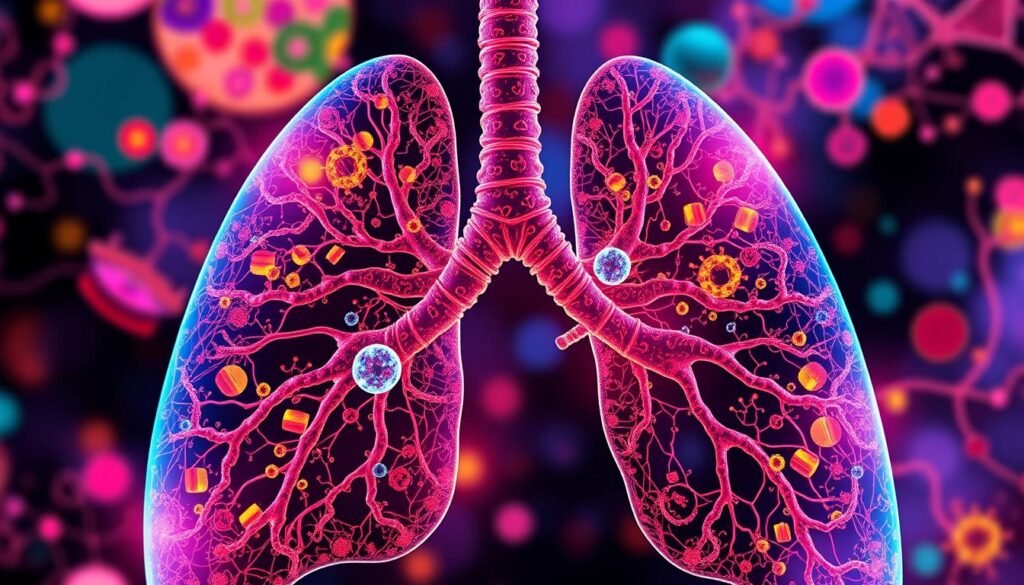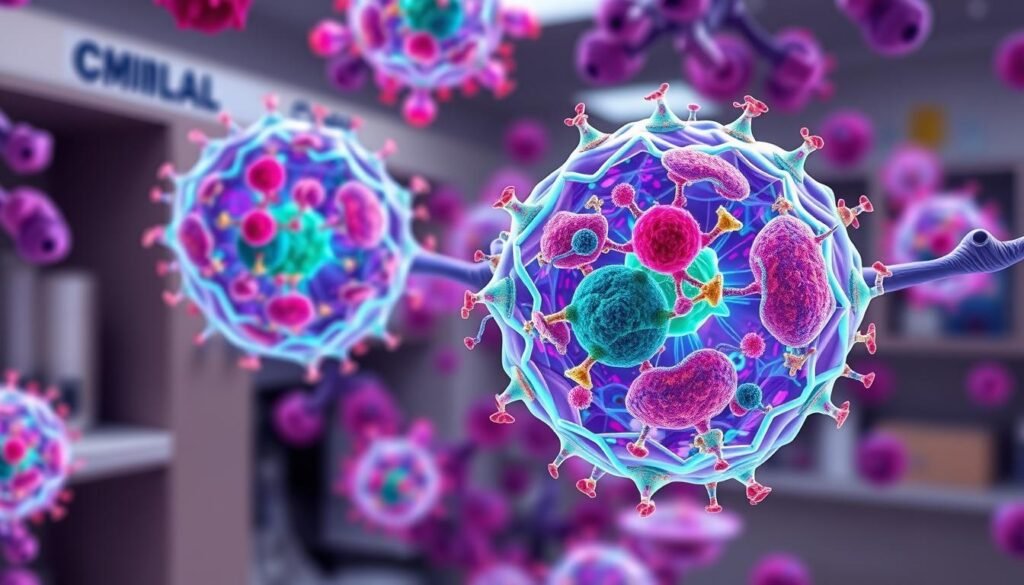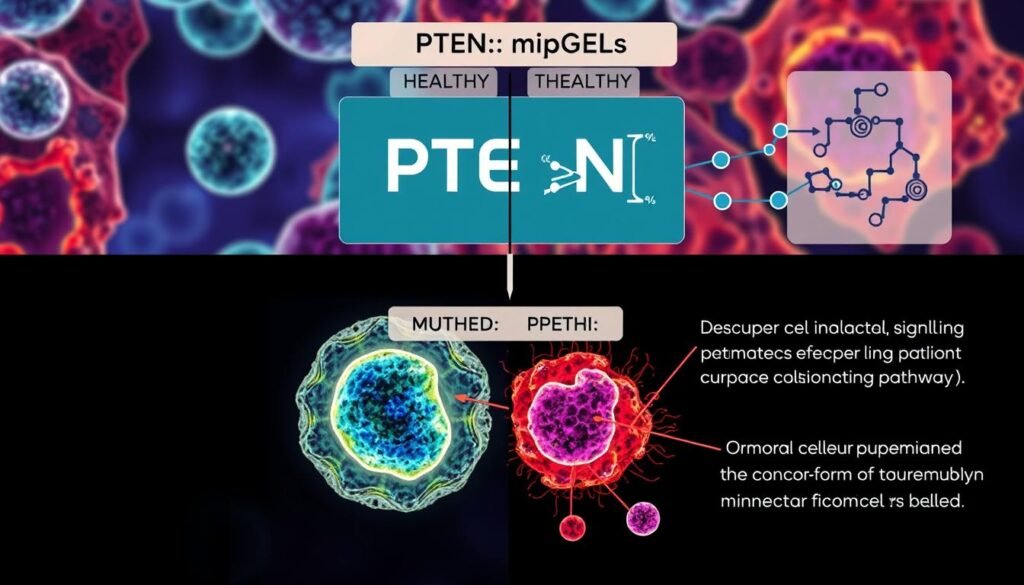Did you know about small cell lung cancer (SCLC)? It makes up about 14% of all lung cancer cases. In the U.S. alone, about 31,000 people are diagnosed each year. This cancer type grows quickly and often leads to a low survival rate of less than 7% over five years. Understanding the mutations in SCLC is key to finding effective treatments.
This guide will cover important mutations linked to SCLC, like TP53 and RB1. We’ll also look at new targeted therapies. These insights will help patients and doctors choose more personalized treatments, potentially leading to better results.
In this article, we focus on the complex mutations in lung cancer and how they affect treatment, especially in SCLC. As research and treatments improve, staying informed is vital. This knowledge opens up new chances to enhance patient care.
Key Takeaways
- Small cell lung cancer represents around 14% of all lung cancers.
- Approximately 31,000 patients are diagnosed with SCLC annually in the U.S.
- Understanding mutations is critical for personalized treatment strategies.
- The majority of patients are diagnosed with extensive-stage disease.
- Advancements in treatment options have been limited for over three decades.
- Key mutations include TP53 and RB1, which significantly affect prognosis.
- Current research is ongoing to explore novel therapies for better outcomes.
Introduction to Small Cell Lung Cancer
Small Cell Lung Cancer (SCLC) makes up about 15% of all lung cancer cases in the US. It is mainly caused by tobacco smoke, leading to 85% of lung cancer cases. This cancer grows rapidly and is often found at a late stage.
About 60%-70% of people with SCLC have widespread disease when diagnosed. This leads to a challenging prognosis.
Each year, the US sees over 200,000 new cases of lung cancer. These result in more than 150,000 deaths. The five-year survival rate for SCLC has gone from 4.9% to 6.4% from 1983 to 2012. Despite slight improvements, the survival outlook is still not good. This highlights the urgent need for more research and better treatments.
SCLC is more common in men, but the male-female gap has been closing over the last 30 years. White people are diagnosed more often than African Americans. Almost all SCLC tumors have changes in a part of chromosome 3p. This includes the loss of the FHIT tumor suppressor gene.
SCLC can also lead to paraneoplastic syndromes like SIADH, ectopic Cushing syndrome, and Lambert-Eaton Myasthenic syndrome. Treatment depends on how far the cancer has spread. People with limited-stage disease may get treatments aimed at curing, like radiation and chemotherapy. Yet, options for this aggressive cancer are still limited, showing a clear need for new treatments.
Understanding Small Cell Lung Cancer Mutations
Small cell lung cancer (SCLC) is well-known for its aggressive nature and poor survival rates. In fact, its 5-year survival rate is less than 7%. This cancer’s behavior is shaped by mutations in genes like TP53 and RB1. Over 90% of SCLC cases have changes in these genes.
This cancer has a high tumor biology complexity. It is marked by a high number of genetic changes. For instance, there are about 8 protein-changing mutations per million nucleotides. Most of these are due to exposure to cigarette smoke, with 95% of patients being smokers.
Many SCLC tumors have lost the function of RB1 and TP53. The TP53 gene often has missense mutations, affecting how DNA binds. Substitutions like R273L and Y220C show the range of these genetic changes. About 13% of cases also see mutations in the TP73 gene.
Knowing about these mutations helps doctors understand and treat SCLC. It helps predict how tumors will respond to treatments. This knowledge is key to making new therapies that target specific mutations. Studying these mutations allows researchers to find new ways to fight cancer.
| Gene | Mutation Type | Percentage of Cases Affected |
|---|---|---|
| TP53 | Missense mutations | 98% |
| RB1 | Loss-of-function mutations | 91% |
| TP73 | Various mutations | 13% |
Key Mutations in Small Cell Lung Cancer
It’s key to know about mutations in small cell lung cancer (SCLC) for new therapies. TP53 and RB1 mutations are crucial. They make SCLC very aggressive and complex.
TP53 Mutations
TP53 mutations happen in 75% to 90% of SCLC cases. This issue messes up the p53 protein that controls cell growth and death. So, cells grow uncontrollably, making the cancer spread fast.
RB1 Mutations
RB1 mutations are found in almost all SCLC cases, making the tumor grow fast. Losing RB1 messes up cell cycle control. This issue, combined with TP53 mutations, fuels the rapid spread of SCLC.
Other Understanding Relevant Mutations
Other gene changes also occur in SCLC, like KRAS, MET, and PIK3CA mutations. But their roles are not fully understood yet. Researchers are working hard to learn more about these mutations and how they affect SCLC treatment.
| Mutation Type | Prevalence (%) | Function |
|---|---|---|
| TP53 mutations | 75-90 | Regulates cell growth and apoptosis |
| RB1 mutations | Almost universal | Deregulates cell cycle control |
| Other mutations | Variable | Includes KRAS, MET, PIK3CA |
Role of EGFR Mutations in Lung Cancer
EGFR mutations greatly affect treatment plans for lung cancer, especially non-small cell lung cancer (NSCLC). NSCLC makes up about 80% of lung cancer cases. While not as common in small cell lung cancer (SCLC), EGFR mutations are still key. Testing for EGFR mutations helps pick targeted treatments, boosting patient outcomes.
EGFR Exon Variants
Important EGFR exon variants include exon 19 deletions and the L858R mutation in exon 21. These mutations respond well to targeted drugs like EGFR inhibitors. Knowing these variants’ role in lung cancer is vital for effective treatments.
Drugs like Afatinib and Erlotinib are leading the way in treating these mutations. This highlights the shift towards personalized medicine in lung cancer care.

Clinical trials are critical for discovering new treatments. They give patients access to new drugs that might be better than the current options. Combining EGFR inhibitors with chemotherapy is now a common strategy, creating more treatment options.
Research and trials specifically looking at EGFR mutations are expanding. This means the way we treat lung cancer is quickly improving.
ALK Rearrangements in Small Cell Lung Cancer
Anaplastic lymphoma kinase (ALK) rearrangements are rare but crucial in small cell lung cancer (SCLC). While these mutations typically occur in non-small cell lung cancer (NSCLC), finding them in SCLC means different treatment options are needed. When ALK rearrangements are found, treatments such as ALK inhibitors including Alectinib might be the right choice.
A study highlighted a case of a 26-year-old non-smoker diagnosed with SCLC. He had an ALK rearrangement. After taking Alectinib at 600 mg twice daily, he showed a major improvement. He lived six more months without the cancer getting worse and did not have serious side effects. Later tests showed a drop in his ALK mutation levels, proving the treatment worked.
ALK rearrangements in SCLC are very rare. Before, only three such cases had been reported. The story of the young man shows how targeted treatments can help. His ALK mutant level dropped significantly after treatment, highlighting Alectinib’s effect.
Even though ALK rearrangements in SCLC are uncommon, their discovery is important. They signal a need for specific research and treatment strategies. Knowing about these genetic changes could lead to better treatments. This could improve survival for people with this aggressive lung cancer type.
ROS1 Rearrangements and Their Implications
ROS1 rearrangements are key in lung cancer, especially in non-small-cell lung cancer (NSCLC). About 1.7% of NSCLC tumors have this genetic change. It’s important in a small group of lung cancer cases. People with ROS1 rearrangements are usually younger. They are more likely to have never smoked compared to those without the mutation.
Treating ROS1 rearrangements in cancer is significant. Tumors with ROS1 rearrangements are all adenocarcinomas. This detail helps doctors choose targeted treatments. Using the drug crizotinib, which targets ROS1, has shown promise. It has helped the HCC78 ROS1-rearranged NSCLC cell line respond well. Patients have seen their tumors shrink, showing this therapy could work well in treating lung cancer.

ROS1 rearrangement might be overlooked without focused genetic testing. Treatment depends on the fusion partners linked with ROS1, like CD74 and EZR. This shows why complete genetic tests are crucial in lung cancer treatment. It leads to personalized treatment plans. Also, about 36% of ROS1-positive patients have other mutations that need careful thought in treatment planning.
ROS1 changes in lung cancer bring both challenges and opportunities. Knowing about these changes helps doctors make better treatment choices. This highlights why testing for these mutations is vital for giving patients specific treatments that can help them more. Ongoing clinical trials add to our understanding of ROS1 in treatment. For more insights, check out latest lung cancer trials. They aim to improve how we treat lung cancer today.
Kras Mutations and Treatment Options
KRAS mutations are key in small cell lung cancer, making up about 25% of cases. They are common in smokers and lead to a tougher type of cancer. This affects how doctors treat the cancer. Testing for these mutations is key. It helps doctors choose the best treatment for each patient.
Kras Testing and Outcomes
Getting tested for KRAS mutations can change things for patients. The biggest variant found in lung cancer is KRAS G12C. It’s in almost half of the KRAS-positive cases. Two pills, sotorasib (Lumakras) and adagrasib (Krazati), have gotten the green light from the FDA. They offer hope to those whose cancer has gotten worse after the first treatments.
Besides targeted therapy, standard treatments include surgery, radiation, immunotherapy, and chemo. This depends on how advanced the cancer is. The push for better treatments for KRAS-positive lung cancer is strong. Many clinical trials are happening now. They focus on new therapies for different KRAS mutations. This big change points to a future of treatment tailored to each patient, tackling this tough cancer head-on.
| KRAS Mutation Type | Prevalence (%) | FDA-Approved Treatments |
|---|---|---|
| G12C | ~50 | Sotorasib (Lumakras), Adagrasib (Krazati) |
| Other KRAS Variants | ~50 | Under Clinical Trials |
| Overall Lung Cancer | 25 | Standard Therapies |
Knowing about KRAS mutations helps doctors pick the best treatments for small cell lung cancer. It shows why more research and treatments designed for each patient are important.
Impact of PTEN and PIK3CA Mutations
Diving into PTEN and PIK3CA mutations helps us understand their place in small cell lung cancer (SCLC). These mutations impact how we view tumor biology and the way we treat this cancer. PTEN mutations, for example, can shorten a patient’s life.
On the other hand, PIK3CA mutations appear in 2-7% of non-small cell lung cancer (NSCLC). They are more often found in squamous cell carcinoma than adenocarcinomas.
Current Research on PTEN Mutations
Researchers are looking into how PTEN mutations affect survival and treatment. They are working on treatments that target both PTEN and PIK3CA mutations. It seems patients with high PIK3CA and low PTEN might have shorter lives.
It has been found that a combination of PTEN loss and PIK3CA gain can lead to worse treatment results. This makes these mutations important targets for therapy. For those interested, you can learn more about the importance of PIK3CA mutations in studies like this one.

Importance of MET Amplifications in SCLC
MET amplifications are key in understanding small cell lung cancer (SCLC). Such changes are found in roughly 5% of lung cancer cases. They greatly affect treatment choices. MET amplifications can make tumors more aggressive. This affects patients’ overall prognosis and treatment options.
Studies show that adenocarcinoma has most MET changes, including exon 14 skipping. Squamous non-small cell lung cancer (NSCLC) can have them too. Next-generation sequencing (NGS) helps find these changes. It guides doctors in choosing the best treatment.
The right treatment is very important for patients with MET exon 14 skipping. Drugs like capmatinib (Tabrecta) and tepotinib (Tepmetko) are used. These drugs work well for certain mutations. Plus, there are ongoing trials for more MET inhibitors. This makes knowing the molecular details of SCLC patients crucial.
Patients with MET gene amplification may receive immunotherapy. It can be with or without chemotherapy. There’s a lot of research on MET changes going on. This research stresses the need for clinical trials. They help find new treatments and learn more about these gene changes.
| MET Alteration Type | Prevalence | Treatment Options |
|---|---|---|
| MET Exon 14 Skipping | 5% of lung cancers | Targeted therapies (Capmatinib, Tepotinib) |
| MET Gene Amplifications | Relatively uncommon | Immunotherapy with/without chemotherapy |
| Other MET Alterations | Occasional in squamous NSCLC | Under investigation in clinical trials |
It’s vital to understand MET amplifications in SCLC. Each change informs treatment choices. Our goal is better care for patients.
Small Cell Lung Cancer Mutations: Current Treatment Strategies
Small Cell Lung Cancer (SCLC) is tough to treat because it’s very aggressive and complex genetically. About 13% of all lung cancer cases are SCLC. Knowing the mutations in SCLC is key to finding the best treatments. Treatment plans often use the genetic changes in the cancer to choose the best therapy.
Standard Chemotherapy Approaches
Limited-stage SCLC treatment usually combines platinum-based chemotherapy with radiation. This approach tries to quickly control the disease. For extensive-stage SCLC, chemotherapy is the main treatment option. This reliance on chemotherapy comes from the common loss of TP53 and RB1 genes in SCLC.
Unfortunately, less than 7% of patients survive five years after diagnosis. This shows a critical need for better treatments.
Emerging Targeted Therapies
With more knowledge about SCLC mutations, new targeted therapies offer hope. Even though chemotherapy has been the main strategy, genetic studies bring the promise of personalized therapy. Treatments targeting mutations in epigenetic regulators and the NOTCH family show promise. Joining clinical trials is crucial to test these new treatments and improve survival and life quality for patients.
Research on SCLC mutations is making it easier to tell different types of the disease apart. This helps in finding the right treatment for each patient.
Clinical Trials and Future Directions in SCLC Treatment
Small Cell Lung Cancer (SCLC) is hard to treat, with few options and poor outcomes for many. Future directions in SCLC treatment are being explored through clinical trials. These trials test new therapies aimed at SCLC’s complex genetics. They are crucial for assessing the potential of new treatments to better patient lives.
Research shows SCLC has a very high mutation rate. This fact allows for personalized treatments targeting these mutations. Yet, only a few patients have mutations in well-known genes like BRAF and PTEN. But clinical trials hold the key to finding new treatments.
Some trials are combining immunotherapy with traditional chemotherapy. For example, the IMpower133 trial showed adding atezolizumab boosts survival rates. This points to a promising SCLC treatment path. The CASPIAN trial also showed benefits in combining durvalumab with chemotherapy, proving combination treatments work well.
Since 85% of SCLC is diagnosed late, new treatment strategies are crucial. Clinical trials focus on new drugs and combining therapies to extend lives. More trials mean better future treatments and outcomes for SCLC patients.
Conclusion
It’s vital to grasp the role of mutations in small cell lung cancer (SCLC) for better treatments and outcomes. The genetic makeup of SCLC shows key changes in genes like TP53 and RB1, leading to its rapid spread. Research on these mutations is uncovering treatment insights that could bring about new ways to boost survival chances.
Though the survival rate has been low, with less than 7% living past five years, there’s hope. Genomic advances are opening doors to targeted and immune therapies, changing how we fight SCLC. With ongoing studies on therapeutic targets, personalized and more effective treatments are becoming a real possibility.
Understanding SCLC mutations is crucial for developing innovative treatments and caring strategies. As science moves forward, genetic testing will be key in crafting tailored treatment plans. This approach aims for better results for people dealing with small cell lung cancer.